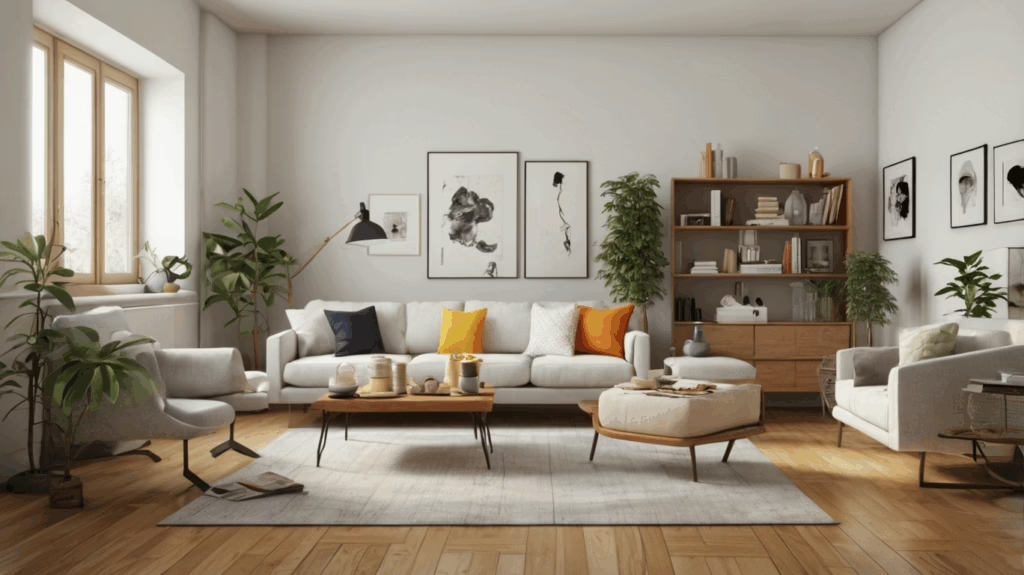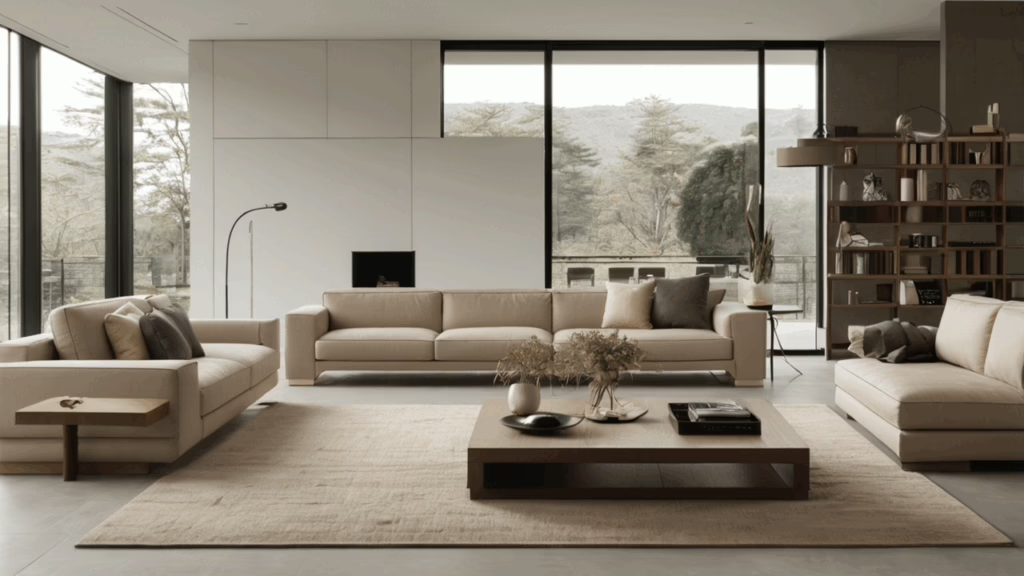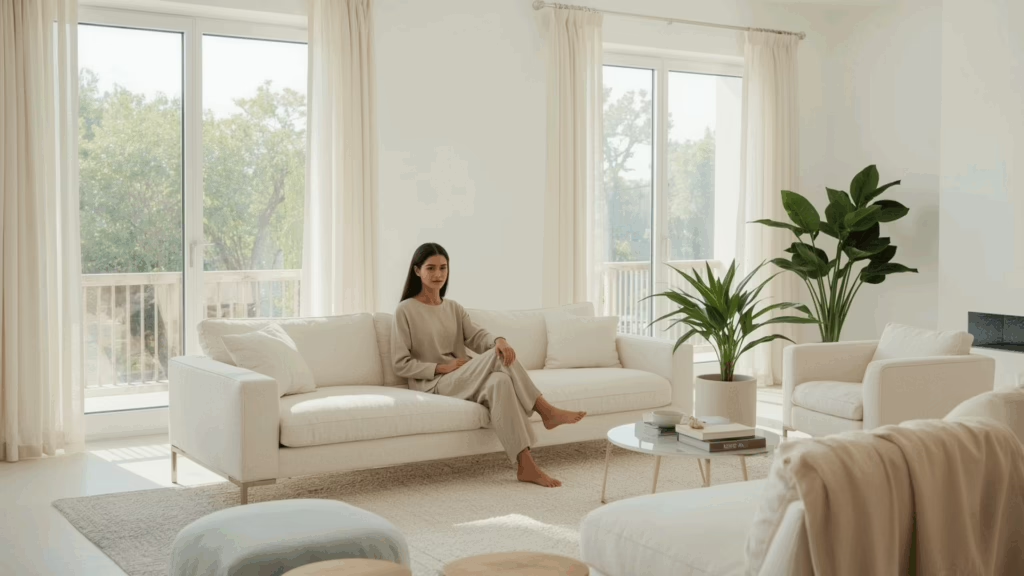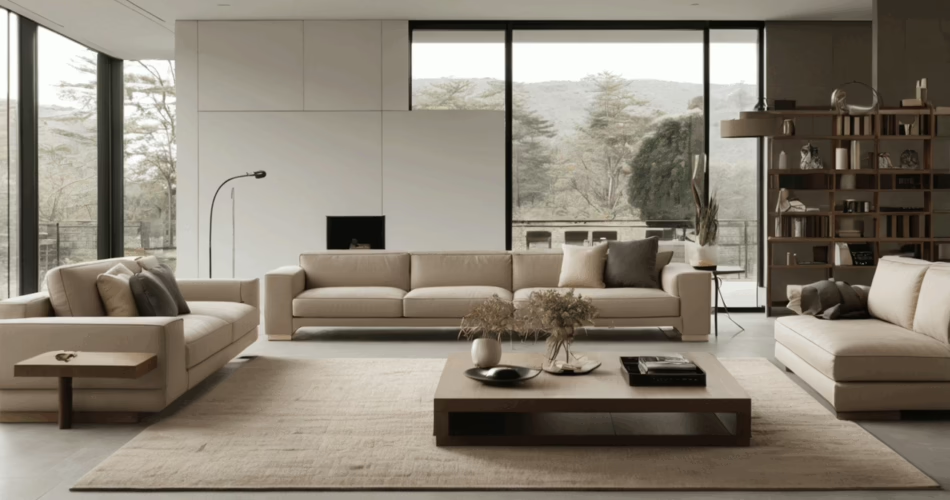Why a Minimalist Furniture Living Room Is More Than Just a Design Choice

When someone first hears “minimalist furniture living room,” they might picture a cold, empty space stripped of personality. But the truth is quite the opposite. Choosing minimalism for your living room isn’t just about style — it’s about creating an environment that helps you breathe easier, think more clearly, and live with intention. It’s not just about what you remove — it’s about what you invite in.
Think about how you feel when you walk into a cluttered space. The overstuffed sofa, the side tables covered in papers, the decor that once brought joy but now fades into visual noise — all of it takes up mental energy. Now imagine stepping into a space with just the essentials. A sofa that welcomes you. A table that’s always clear. Light pouring through the windows without being blocked by things that don’t serve a purpose. That’s not just design — that’s a reset for your soul.
Minimalist furniture helps establish this reset. It forces us to ask: “What do I actually need here?” It prompts mindfulness, and it turns the living room — once a chaotic hub — into a quiet sanctuary. The choice of fewer, better pieces isn’t a style trend. It’s a decision to reclaim your peace.
How I Decluttered and Redefined My Living Room with Minimalist Furniture

I didn’t start with a Pinterest-perfect vision. I started with overwhelm. Every time I walked into my living room, I felt distracted — and oddly drained. There were too many things trying to be the center of attention: mismatched chairs, shelves stuffed with unread books, decorative pieces that had lost meaning over time. I realized I didn’t live in this room anymore. I dodged it.
The turning point came when I asked myself, “What do I actually use — and what do I truly love?” That question sparked a weekend purge. I started with the obvious: the broken side table, the chair that no one ever sat in, the storage unit filled with things I hadn’t touched in years. I let go of guilt and the “just in case” mindset. With every item that left, the room exhaled a little.
Next, I focused on rebuilding — slowly. I kept the couch we all gravitated to. I added one clean-lined coffee table that actually served its purpose. I didn’t fill blank walls immediately. Instead, I lived in the space. I listened to the quiet and learned what it needed. A lamp in the corner. A cozy throw. Nothing rushed. Every piece became intentional.
Redefining my living room wasn’t about stripping it bare. It was about stripping it down to the best version of itself. And in the process, I found a version of myself I hadn’t met in a while — someone calm, grounded, and fully present.
Choosing the Right Minimalist Furniture for Your Living Room

When creating a minimalist furniture living room, the goal isn’t just to own less — it’s to own better. The right pieces should offer both form and function. They should quietly serve your lifestyle without demanding your attention every time you walk into the room.
Start by identifying the essential anchors: your sofa, coffee table, and storage. For the sofa, look for clean lines, neutral tones, and comfort you’ll actually use. Avoid bulky cushions and oversized armrests — they take up space without adding real value. If you can, choose a raised-leg sofa; it opens up the floor visually, making your space feel lighter.
Your coffee table should serve multiple purposes — maybe it has hidden storage, maybe it doubles as a footrest. Skip the overly decorative options and lean toward wood, glass, or matte finishes. Simple doesn’t mean boring. In fact, one well-chosen piece can quietly elevate the entire space.
Storage is where minimalism meets practicality. Opt for closed storage when possible. Open shelving can work, but only if you’re intentional about what’s displayed. Consider furniture with built-in storage: a bench with a hidden compartment or a console table that tucks away your daily clutter.
Finally, resist the urge to fill empty corners right away. Minimalist furniture gives your living room space to breathe — and that space is part of the design. It’s where your eyes rest. Where your mind resets.
The Science Behind Minimal Spaces and Mental Clarity
There’s more to a minimalist furniture living room than just aesthetic appeal — science backs up its emotional and cognitive benefits. Our brains are wired to process our surroundings, and every object within view becomes a piece of data we unconsciously absorb. The more visual noise, the more our mental load increases — even when we don’t realize it.
Studies from institutions like Princeton University Neuroscience Institute have shown that physical clutter competes for your attention, leading to decreased performance and increased stress. In simple terms: clutter overwhelms your brain. When your space is chaotic, it’s harder to concentrate, make decisions, and feel at peace. But when your environment is calm, your mind follows suit.
This is where minimalist furniture plays a powerful role. Clean lines, clear surfaces, and open floor space reduce visual input. Fewer distractions lead to more cognitive freedom. Even natural light has a stronger impact in a minimal space — it flows freely without obstruction, lifting your mood and regulating your circadian rhythms.
Minimalist design also enhances mindfulness. When your space isn’t demanding constant maintenance or attention, you naturally slow down. You start to notice the little things: the way sunlight hits the floor in the morning, the sound of quiet, the comfort of your favorite chair.
A minimalist living room doesn’t just look better — it feels better. It helps your brain rest. And in a world that constantly shouts for your attention, that silence is priceless.
Real-Life Benefits I Noticed Within a Week of Going Minimal

I didn’t expect big changes right away when I committed to a minimalist furniture living room. But the shifts came faster — and deeper — than I imagined. Within a week, I found myself breathing easier, not just metaphorically, but literally. The space felt open, the air seemed lighter, and the tension I didn’t even know I was holding began to melt.
One of the first changes I noticed was how easy it became to clean. With fewer surfaces and no unnecessary furniture to shuffle around, I could tidy up in minutes. That small win gave me more time — and strangely, more energy. I started using my living room again: reading, praying, stretching, talking — not just zoning out with the TV.
Conversations in the space felt different, too. Without clutter crowding us, there was more room for connection. I didn’t have to mentally apologize for the mess. Friends commented on how “calming” the space felt. And honestly, I agreed.
There were other, more subtle shifts. I spent less time scrolling on my phone. I found myself wanting to be in the room, not just pass through it. I became more mindful of what I brought in — not just furniture, but habits, thoughts, energy.
Minimalism didn’t fix my life overnight, but it cleared a path. And that path led to better rest, more peace, and a new sense of ownership over how I lived at home.
Design Tips to Keep Your Minimalist Living Room Warm and Inviting
One of the biggest misconceptions about a minimalist furniture living room is that it feels sterile or cold — like a showroom instead of a home. But minimalism done right is anything but lifeless. In fact, it can feel more welcoming and soul-nourishing than a space filled with stuff, especially when you bring in the right textures, tones, and warmth.
Start with natural materials. A soft linen throw, a woven jute rug, a wooden side table — these aren’t clutter. They’re comfort. Textures create depth, especially when color is kept simple. Go for warm neutrals: soft beiges, muted whites, deep greys, and earthy browns. These tones reflect light beautifully while creating a cozy, grounded feel.
Add a few living elements. A single leafy plant in the corner can breathe life into the whole room. Even a small cactus on the windowsill or a vase of eucalyptus on the coffee table can break the visual monotony and add gentle movement and scent to your space.
Lighting also matters. Avoid harsh overhead lights. Instead, use soft, layered lighting — a floor lamp, a table lamp, or string lights tucked into a bookshelf. Lighting shapes mood, and in a minimalist setting, it’s your best tool to turn “bare” into “beautiful.”
Remember, negative space is part of the design. Don’t rush to fill every wall or corner. Let the room breathe. Let it welcome you.
Sustainable and Affordable Minimalist Furniture Choices
Creating a minimalist furniture living room doesn’t have to mean draining your bank account or compromising your values. In fact, one of the quiet joys of minimalism is that it often leads to more sustainable and affordable choices — if you’re willing to pause and choose with intention.
Start with secondhand. Thrift stores, estate sales, and online platforms like Facebook Marketplace, AptDeco, or even Craigslist are goldmines for minimalist pieces. Look for solid wood, metal frames, or mid-century designs — they age beautifully and often cost less than mass-market options. Choosing used isn’t just budget-friendly; it’s planet-friendly too.
If you’re buying new, opt for brands with transparent sustainability practices. Companies like Article, Floyd, or Burrow offer modern, modular furniture with a minimalist look and eco-conscious materials. IKEA is another viable choice, especially when paired with a mindful shopping approach — buy only what you truly need, and don’t fall for add-ons.
DIY and upcycling are underrated minimalist strategies. A simple sanding and coat of matte paint can transform an old coffee table into a focal point. Repurposing a storage bench or reupholstering a chair gives new life to what you already have.
Minimalism reminds us: furniture isn’t disposable. Choose pieces that last — and ones that tell a story. Because in a room where everything has a purpose, the simplest items often hold the most meaning.
Final Reflection: Your Living Room, Your Peace
When you strip away the excess, something unexpected rises to the surface: peace. A minimalist furniture living room isn’t about achieving a look — it’s about creating a space that aligns with who you are and what you need. It’s about choosing calm over chaos, clarity over noise, and purpose over pressure.
This journey isn’t about perfection. It’s not about making your home magazine-worthy or impressing guests. It’s about building a space where you can finally rest. Where your surroundings support your spirit instead of competing for your attention.
In this space, you’ll begin to notice more — not less. The quiet hum of morning light. The comfort of a well-loved chair. The joy of being able to find what you need because there’s not much standing in the way. Minimalist living room furniture helps create margin — and within that margin, life breathes.
Your living room is more than just a space. It’s a reflection of your rhythms, your values, your peace. And when it’s filled with less — intentionally, lovingly — you’ll discover it’s already more than enough.

